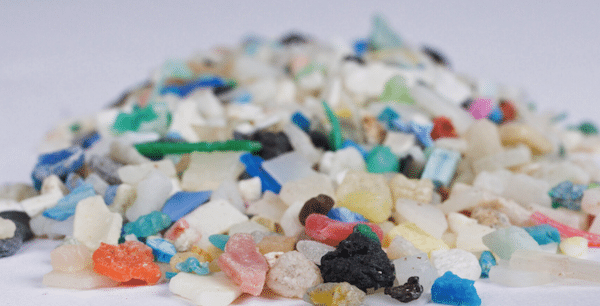- Trillions of microplastic particles in the ocean threaten marine life, from huge filter-feeders to tiny plankton. Although not lethal in the short term, the long-term impacts of microplastics on plankton and marine microbes could disrupt key Earth systems such as ocean carbon storage and nitrogen cycling.
- Oceans represent Earth’s largest natural carbon store and are crucial to mitigate atmospheric CO2 increase. Carbon taken up by plankton and stored in the deep ocean–known as the biological carbon pump–is a major process in ocean carbon storage. Microplastics may “clog” this pump and slow ocean carbon uptake.
- Microplastics in marine sediments alter microbial communities and disrupt nitrogen cycling, potentially magnifying human-caused problems like toxic algal blooms. Changes in plankton communities at the ocean surface could exacerbate deoxygenation driven by climate change, starving marine organisms of oxygen.
- Small plastic particles are impossible to remove from the oceans with current technology, so stopping pollution is a priority. Plastic production continues to soar year-on-year, but a U.N. treaty to address plastic pollution could offer a glimmer of hope that the international community is ready to take action.
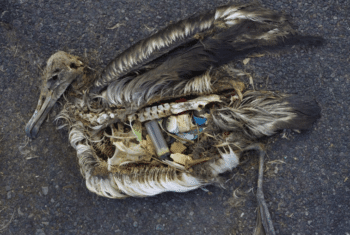
Stomach contents of a dead albatross chick. Plastic debris is already estimated to cause the deaths of more than a million seabirds every year, and more than 100,000 marine mammals, according to UNESCO. But this is only the most visible and immediate impact of ocean plastic pollution; other impacts are less visible and potentially more threatening to Earth’s operating system. Image by Chris Jordan via Wikimedia Commons (CC BY 2.0).
Heart-wrenching images of sea turtles entangled in fishing nets, or dead seabirds with stomachs clogged by plastic trash, justifiably attract media and public attention. But zoom down to the microscopic scale and plastics are having far more pervasive, insidious effects on ocean life–even potentially impacting key Earth operating systems that keep the planet habitable.
An estimated 12 million metric tons of plastic currently enters the ocean each year. This plastic debris gradually breaks down into smaller and smaller fragments–micro- and nanoplastics–which, while less visually striking, can have serious effects on marine ecosystems and may even pose a threat to the stability of Earth’s climate.
A recent estimate suggests that as much as 358 trillion microplastic particles are floating on the surface of the world’s oceans, with untold trillions more in deeper reaches. Their prevalence is particularly worrisome because these tiny particles are easily mistaken as food by marine life. The smaller the microplastic particles, the more species that can ingest them, from huge filter-feeding whales to tiny organisms at the base of the food chain collectively known as plankton.
“Microplastics truly are omnipresent in these environments,” says Carroll Muffett, president and CEO of the Center for International Environmental Law, adding that “they are affecting marine biota at every trophic scale.”
Unlike larger plastic litter, which can entangle and suffocate marine animals, microplastics are unlikely to be lethal over short time scales. But their long-term impacts on plankton and microbial communities could have profound implications for marine biodiversity and even hinder carbon storage and nitrogen cycling in the world’s oceans.
Plastic pollution pushes Earth out of ‘safe zone’
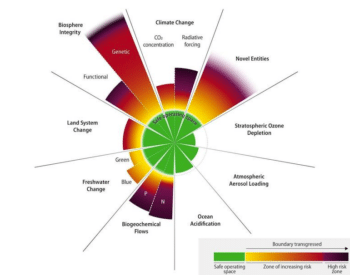
The current risk status of control variables for all nine planetary boundaries, as of 2023 research. Image by Richardson et al 2023.
Plastics, along with other synthetic chemicals and pollutants dubbed “novel entities” by scientists, are considered a threat to the stability of Earth’s operating system because of their persistence in the environment and potential toxicity to humans and wildlife —with the harm done to biodiversity in turn altering life-giving geophysical processes.
The production and release of vast amounts of plastic into marine ecosystems is now being recognized as a key potential threat to environmental stability as defined by the Planetary Boundaries framework. That theory attempts to quantify nine Earth system thresholds that humanity cannot transgress without risking life as we know it.
Researchers suggest we have already exceeded the safe threshold for novel entity chemical pollution.
Plastics are also pushing us further into the danger zone for other planetary boundaries, especially the loss of biosphere integrity and function, through their lethal and sublethal effects on living organisms. Research is also showing that plastics, via their impact on microscopic ocean life, may have knock-on effects, destabilizing three other critical boundaries, including ocean acidification, climate change and biogeochemical flows of nitrogen.
The smallest plastic particles “are likely the ones that pose the biggest planetary boundary threats,” says Meredith Seeley, a postdoctoral researcher studying marine microplastics at the National Institute of Standards and Technology in Maryland, U.S.
Microplastics ‘clogging’ ocean’s living carbon pump?
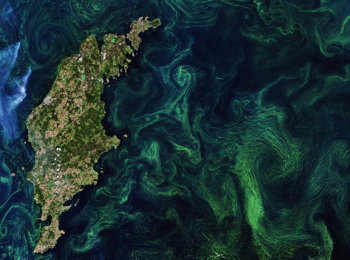
Seasonal green algae blooms in the ocean can be so extensive they are visible from space. Phytoplankton (algae and cyanobacteria) take up carbon to fuel photosynthesis and integrate that carbon into their tissues. When they die, that carbon is gradually carried to the deep ocean where it is stored–a mechanism known as the biological carbon pump. Image by the European Space Agency via Flickr (CC BY-SA 2.0 DEED).
The connection between plastic pollution and Earth’s climate hinges on the critical role tiny marine organisms play in storing carbon in the ocean. Earth’s oceans are the largest natural carbon store, making them crucial to mitigating increases in atmospheric CO2. This carbon-storing function occurs in two steps: First, CO2 in the atmosphere dissolves in seawater at the ocean’s surface. Then, plankton take up that carbon and eventually store it in the deep ocean. The latter process is known as the biological carbon pump.
Plankton is a catch-all term for a diverse array of tiny organisms that float in vast numbers on ocean currents. They come in two main types: Phytoplankton (algae and cyanobacteria that use photosynthesis to harvest solar energy) and zooplankton (the small animals that feed on phytoplankton).
Research shows that exposure to microplastics in high enough concentrations can alter photosynthesis in phytoplankton and reduce feeding rates in zooplankton. Studies have also linked consumption of microplastics by these organisms to reduced growth, lifespan, reproduction and fertility across a range of plankton species. Those impacts can have knock-on effects all the way up the food chain.
Phytoplankton take up carbon to help fuel photosynthesis and they integrate that carbon into their tissues. They are then eaten by zooplankton, whose feces sink to the ocean floor, carrying the carbon with it. When plankton die, they too sink to the bottom, carrying the carbon they contain with them. This stored carbon is then released into deep ocean water through decomposition or buried in seafloor sediments.
“Deeper water is not in contact with the atmosphere, so the carbon is effectively stored in the ocean–this is the biological pump,” explains Karin Kvale, a climate modeler at GNS Science in New Zealand.
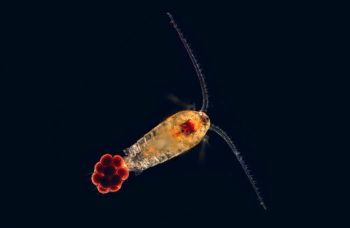
Zooplankton are tiny organisms that float in vast numbers on ocean currents and feed on phytoplankton. Research has found that consuming microplastics slows zooplankton feces’ descent to the deep ocean, potentially dampening the biological carbon pump. Image by Proyecto Agua via Flickr (CC BY-NC-SA 2.0 DEED).
This biological carbon pump is responsible for a large proportion of the carbon stored in the ocean. Estimates suggest this stored carbon is equivalent to between 100 and 400 parts per million in the atmosphere; if it were all released at once, that would be more than enough to thrust the planet into a new, ‘hothouse’ climate system.
Thankfully, the oceans are not at risk of giving up all that stored carbon anytime soon, but mounting evidence suggests that microplastics could impair the biological carbon pump, reducing the rate at which the seas take up humanity’s excess carbon emissions.
“Zooplankton and phytoplankton together form the foundation of the biological carbon pump. That is one of the primary mechanisms through which the oceans protect humans from the true impacts of anthropogenic greenhouse gases,” Muffett explains.
Research shows that “microplastics are getting caught in this mechanism,” altering how feces and other organic particles form, sink and break down in the ocean, Kvale says.
Zooplankton are easily fooled into eating microplastic particles, and these synthetics either remain in their bodies or are incorporated into their feces. Plastic-laden feces are more buoyant, which slows their descent to the ocean floor–potentially slowing and disrupting ocean carbon storage. “What the net effect might be on biological carbon pumping is still unknown,” Kvale notes.
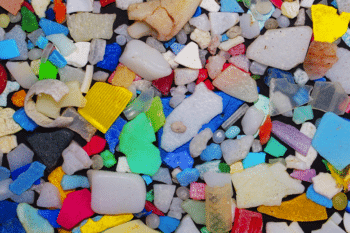
Estimates suggest it could take thousands of years for plastics to fully break down in the environment, but over time, bigger pieces continue degrading into smaller and smaller microplastics and nanoplastics. The longer these tiny synthetic particles affect the ocean food chain and alter the transport of carbon to the seafloor, the greater their potential impact on the biological carbon pump and global climate. Image by Wolfram Burner via Flickr (CC BY-NC 2.0 DEED).
Studies suggesting that microplastics might weaken the biological carbon pump have caused alarm among scientists and conservationists. “I’ve been researching the impacts of climate scenarios for more than 30 years, and I can count on one hand the moments where I was presented with something that fills me with absolute terror,” Muffett says.
The realization of the potential impacts of microplastics on the biological carbon pump was one of those moments.
But Kvale emphasizes that this research is in its infancy. Laboratory experiments and computer modeling have shown that microplastic pollution could impact global carbon cycling, “but there is still no evidence these impacts are occurring in nature,” she explains.
Plastic persistence may spell long-term trouble
The effects of a dampened biological carbon pump will take time to be felt, Kvale says. That’s because, while the pump plays a key role in storing carbon, it impacts climate relatively slowly compared with other mechanisms, such as carbon dioxide absorption by the ocean surface.
“The biological carbon pump is responsible for a lot of carbon held in the ocean, but it operates on climate over millennial time scales,” she notes.
Computer modeling by Kvale and colleagues suggests that the impact of microplastics on global carbon cycling will be significantly smaller in the near term than the damage caused by direct carbon emissions from burning fossil fuels, producing the plastics themselves and other human activities. But the longer microplastic particles move through the ocean food chain, altering the transport of carbon to the sea floor, the greater their potential impact on the biological carbon pump and global climate.

Microplastics can affect microbial communities in aquatic sediments, changing the composition of species and altering their nitrogen cycling activity. This could push Earth closer to the danger zone for the biogeochemical cycling planetary boundary. Image courtesy of the National Park Service via Wikimedia Commons (Public domain).
“If microplastic particles influence the organic particle sinking for many centuries or longer, then there might be significant climate effects,” Kvale says.
A big unknown is how long microplastic particles will remain in the ocean before they are eventually broken down into their molecular components–mainly carbon and hydrogen. Estimates suggest this decay is likely to take hundreds or even thousands of years, depending on the type of plastic and its journey through the ocean. That slow breakdown underscores the importance of research into how microplastics will influence the biological carbon pump over the long term.
“If this were the only reason to confront the plastic crisis, it alone would be reason enough, and yet it is only the latest reason in an accelerating litany of impacts,” Muffett says.
Sinking microplastics disrupt base of food chain
When the feces and bodies of plankton contaminated with microplastics sink, they carry plastics from the surface to the deep ocean, potentially impacting seafloor organisms that play important roles in nutrient cycling and pushing us closer to the danger zone for yet another planetary boundary–biogeochemical flows of nitrogen.
Seeley and her colleagues have found that certain microplastics can affect microbial communities in aquatic sediments, changing their species composition and altering their nitrogen cycling activity.
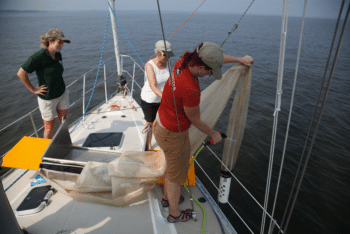
Estimates of microplastic concentrations in the ocean are limited in their accuracy by the sensitivity of the equipment used to measure them–from the mesh size of nets or pore size of filters used to collect samples to the instrument resolution used to detect particles within samples. Image by the Chesapeake Bay Program via Flickr (CC BY-NC 2.0 DEED).
“Those microbes are the ecosystem engineers at the base of that food web–they’re the ones processing all sorts of organic matter from the environment and making sure that healthy nutrient cycling is being conducted for the rest of the food web,” Seeley explains.
This alteration of microbial nutrient cycling could magnify the ecological consequences of already occurring human changes to natural nutrient cycling, possibly intensifying harmful aquatic algal blooms caused by synthetic fertilizer runoff.
Evidence that microplastics’ sublethal effects on microbial communities “might alter biogeochemical cycling is really good evidence of reaching that planetary boundary level,” Seeley warns.
Microplastics may knock the breath out of the ocean
Microplastic pollution could also be worsening oxygen loss in ocean waters–an impact already being driven by synthetic fertilizer pollution and by climate change.
Global warming is making oceans warmer, and warmer water holds less oxygen. Climate change also disrupts ocean currents and increases ocean stratification, preventing oxygen from reaching deeper waters. These climate-driven causes have added up to ocean oxygen level reductions of more than 2% since 1960.
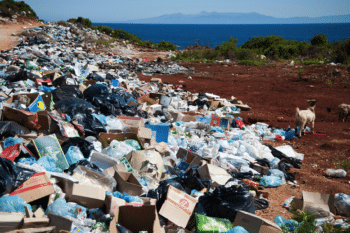
There are more than 13,000 chemical additives associated with plastics that can make up more than 60% of the weight of a final product. But their exact chemical compositions are tightly kept trade secrets, making it very challenging for scientists to determine ocean impacts. Image by Antoine GIRET via Unsplash (Public domain).
Continued declines in oxygen levels could threaten the very ability of ocean life to breathe.
Enter microplastics: Zooplankton that eat plastic have less appetite for their usual food–phytoplankton–which can lead to a buildup of phytoplankton at the ocean’s surface. This excess organic matter, when it dies, consumes oxygen as it rots.
“Oxygen levels are more sensitive to biological changes than are carbon concentrations,” Kvale says, but “we really have no idea yet if the microplastic effects will be significant or insignificant for ocean oxygen.”
Scale and risk of microplastic pollution: many unanswered questions
Scientists’ understanding of the impacts of microplastics on marine ecosystems is hindered by two key challenges: Accurately estimating the scale of global microplastic pollution, and measuring microplastic effects in real-world conditions.
Over the last decade, numerous studies have attempted to calculate the number of microplastic particles at the ocean’s surface, in the water column, and on the seafloor in different regions around the world.
But these estimates are limited by equipment sensitivity–from the mesh size of nets or the pore size of filters used to collect samples to the resolution of instruments used to detect particles within those samples. Often, these methods involve scientists picking out microplastic particles from samples by eye, introducing further inaccuracies into estimates.
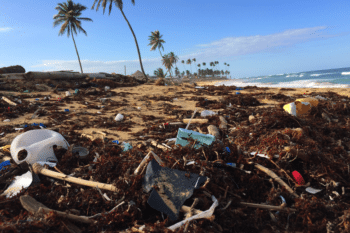
This tropical beach cluttered with plastic debris is only the tip of the global plastics iceberg. As unsightly as this trash can be, mostly invisible waste in the form of trillions of particles of microplastics are polluting Earth’s oceans. Image by Dustin Woodhouse via Unsplash (Public domain).
“Not everyone has access to very sophisticated and expensive instruments and sampling tools,” explains Melanie Bergmann, a biologist at the Alfred Wegener Institute in Germany. This makes comparisons between studies difficult, preventing reliable global estimates of microplastic pollution.
Bergmann says that as much as 80-90% of marine microplastic particles may be missed by standard sampling techniques because they’re too small to be detected.
The exact trajectories of microplastic particles through the ocean and where they accumulate are also big unknowns.
“The [scientific] community is still working on developing a decent understanding of microplastic abundances and distributions in the global ocean, where they came from, how they got there, and where they might end up,” explains Kvale. Understanding these factors is crucial to firming up estimates of how marine microplastics will impact biodiversity and to evaluating carbon and nitrogen cycling effects in the decades ahead.
Microplastics: Into the great unknown
There’s still another major stumbling block to understanding: Interactions between organisms and microplastics are also impacted by the type of plastic–by the chemical additives they contain and even the shape and surface texture of the particle.
These traits vary widely between the many thousands of plastics on the market and can change over the lifespan of the particles as they degrade, combine and interact with other pollutants. “Every plastic [particle] in the ocean is like a snowflake–they’re entirely different from one another,” says Seeley.
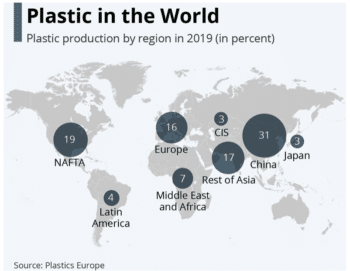
Plastic production by region in 2019 (in percent). The treaty zero draft is a win for environmentalists because it will focus on plastics from cradle to grave and not just on disposal. But the U.S., China and other major plastic producing nations are resistant to a strong comprehensive binding treaty. How the final document will read is anyone’s guess. Image courtesy of Statista.
Sussing out those differences poses yet another hurdle: The exact chemical composition of many plastics are tightly kept trade secrets, so researchers must take on the role of forensics experts to deduce what each one contains.
“There’s more than 13,000 chemicals that are associated with plastics … a quarter of these have been classed as hazardous… [and] the weight of these additives in a product can be more than 60%,” explains Bergmann. Microplastics can also bind to and carry pollutants from the environment, increasing the complexity of the chemical cocktail.
Laboratory studies often use higher concentrations of microplastics than are found in the environment in order to more easily follow their paths through organisms and analyze impacts. Data on the physiological effects of microplastics at realistic concentrations is limited, largely because studying the effects of microplastics in natural settings is so difficult. And today, plastic pollution is so pervasive that there are no pristine natural ecosystems to provide baseline data for comparison.
In part because of these challenges, “The impacts on phytoplankton and zooplankton communities are among the least researched of impacts, which is a staggering oversight given their fundamental importance” for ecosystems, food security and global climate, Muffett notes.
Without sufficient data, scientists and humanity are largely flying blind to the planetary-scale impacts of microplastic pollution, increasing the chances for unforeseen consequences.
Clean up the mess, stop the flow
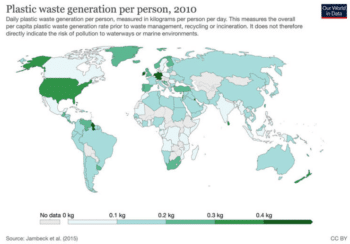
Plastic waste generation per person, 2010. Image courtesy of Our World in Data.
No one seems to know how to attack microplastic pollution already in the ocean. Ambitious plastic cleanup efforts have been launched of late by nations, NGOs and individuals in the hopes of curbing oceanic pollution. But large-scale projects to collect floating plastic waste have been criticized for their carbon emissions, and for harming marine organisms inadvertently caught up by the cleanup devices. The sheer magnitude of the cleanup required is also formidable.
But the longer we wait, the worse things get. “The plastic that’s out there is going to keep fragmenting into smaller and smaller pieces. It’s a little bit daunting to consider that fact,” Seeley says, adding “We’ve reached this point where we can’t really go back.”
But improving our understanding of how different types of plastic and their associated chemicals impact marine organisms could enable more targeted environmental policies to phase out the most damaging types.
“I’d love to see a plastic-free ocean, but in the absence of that, we need to understand what different aspects of plastics are having the greatest impact and then think about how we might alter and reduce those upstream,” says Seeley. Greater transparency from plastics manufacturers would help scientists get a better handle on microplastics and their effects on living organisms, experts tell Mongabay.
But clearly, stopping the flow of plastic pollution into the environment is a top priority.
Landmark international agreement brings cautious optimism
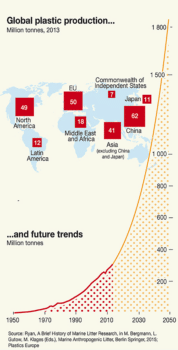
Data from a 2015 report on global plastic production forecasts a rapid exponential production trend through 2050. If that production trend is also accompanied by an exponential ocean pollution trend, microplastic impacts on plankton already detected by scientists could become far worse. The U.N. plastics treaty could blunt the rise in waste, but only if the agreement is given teeth. Image courtesy of Basel Convention.
Despite concern over pollution and ecosystem impacts, global plastic production increases year-on-year. Currently, “we’re on an exponential trajectory for plastic production,” Bergmann warns. Plastic manufacture increased from 2 million metric tons in 1950 to more than 400 million metric tons in 2020, and is predicted to double by 2040.
But with mounting pressure from environmental groups, activists and consumers, there is hope for a solution. The international community is working now to steer humanity off this consumptive course. In March 2022, the United Nations Environment Assembly (UNEA) signed a landmark resolution to negotiate a legally binding international agreement for addressing plastic pollution by the end of 2024.
Negotiations are ongoing, with the zero draft of the treaty released in early September. Encouragingly, that version explicitly addresses plastic pollution in the marine environment–and it does much more: “What is really striking about the global plastics treaty mandate is parties have agreed to look at plastics across [the] entire life cycle,” Muffett says.
However, experts who have spoken to Mongabay express concerns that the final agreement could focus mostly on reducing plastic pollution rates, rather than requiring global production cuts. Plastic producing nations like the U.S. have so far been resistant to a comprehensive binding treaty. They favor a voluntary accord with nationally determined commitments–an approach that has hampered the Paris Agreement’s effectiveness.
Despite these worries, the UNEA plastics treaty is cause for optimism, Bergmann says. “We’ve started to address the health effects of plastics more and we’re also speaking about production caps, which was … unheard of a few years ago.” It is essential that the final text of the treaty is informed by the best available independent science, she says.
The negotiations could also bring a sea change in industry attitudes toward product design and manufacture. “These treaty negotiations have a really powerful signaling function for global markets around plastics,” Muffett suggests.
Considering the many risks and unknowns, scientists agree there’s no time to waste in reducing the source of the problem–extravagant plastic production and consumption. An international agreement on plastics can’t come soon enough.
Citations:
Jambeck, J. R., Geyer, R., Wilcox, C., Siegler, T. R., Perryman, M., Andrady, A., … Law, K. L. (2015). Plastic waste inputs from land into the ocean. Science, 347(6223), 768-771. doi:10.1126/science.1260352
Eriksen, M., Cowger, W., Erdle, L. M., Coffin, S., Villarrubia-Gómez, P., Moore, C. J., … Wilcox, C. (2023). A growing plastic smog, now estimated to be over 170 trillion plastic particles afloat in the world’s oceans—Urgent solutions required. PLOS ONE, 18(3), e0281596. doi:10.1371/journal.pone.0281596
Wieczorek, A. M., Croot, P. L., Lombard, F., Sheahan, J. N., & Doyle, T. K. (2019). Microplastic ingestion by gelatinous zooplankton may lower efficiency of the biological pump. Environmental Science & Technology, 53(9), 5387-5395. doi:10.1021/acs.est.8b07174
Kvale, K., Hunt, C., James, A., & Koeve, W. (2023). Regionally disparate ecological responses to microplastic slowing of faecal pellets yields coherent carbon cycle response. Frontiers in Marine Science, 10. doi:10.3389/fmars.2023.1111838
Koeve, W., Kähler, P., & Oschlies, A. (2020). Does export production measure transient changes of the biological carbon pump’s feedback to the atmosphere under global warming? Geophysical Research Letters, 47(22). doi:10.1029/2020gl089928
Seeley, M. E., Song, B., Passie, R., & Hale, R. C. (2020). Microplastics affect sedimentary microbial communities and nitrogen cycling. Nature Communications, 11(1). doi:10.1038/s41467-020-16235-3
Kvale, K., Prowe, A. E., Chien, C., Landolfi, A., & Oschlies, A. (2021). Zooplankton grazing of microplastic can accelerate global loss of ocean oxygen. Nature Communications, 12(1). doi:10.1038/s41467-021-22554-w
Chemicals in Plastics: A Technical Report. (2023). Retrieved from United Nations Environment Programme website: https://www.unep.org/resources/report/chemicals-plastics-technical-report

